The 8 Types of Windows & Frames Explained | Full Overview
Guide to 8 Types of Windows for Homes
Investing in new windows for your home isn’t an everyday decision – it’s a significant undertaking that many homeowners may only make once in their lifetime.
That’s why it’s crucial to select the most suitable types of windows to replace your current windows, and there are plenty of good reasons why.
At First Class Windows, we’re here to simplify the maze of options with clear, honest advice – just as we did when demystifying U-values for windows. Choosing the right replacement windows really can be as easy as 1, 2, 3.
Types of windows for homes
- Casement Windows
Hinged at the side and opening outward, a casement window functions much like a door and is usually opened with a handle or crank. The absence of a fixed central bar means you get a cleaner, wider view and plenty of fresh air when it’s open – perfect for rooms that need ventilation. - Sash Windows
A classic choice, sash windows comprise one or more sliding panels that move either up and down or side to side. A familiar feature in period homes, particularly from the Georgian and Victorian eras, they operate smoothly thanks to counterbalances or springs, and offer a refined, heritage-inspired aesthetic. - Tilt and Turn Window
True to its name, this window opens in two ways: tilt it slightly from the top for safe, subtle airflow, or open it inward like a door for easy access and cleaning. The tilt and turn design combines practicality with modern versatility, making it a popular choice across home styles. - Sliding Window
Designed with space efficiency in mind, sliding windows move horizontally along a track and are ideal for wide openings or compact areas where outward-opening styles aren’t suitable. Their smooth operation and contemporary look make them both functional and stylish. - Bay Windows
Known for their dramatic outward extension, these types of house windows typically consist of three sections – a central fixed pane and two angled side windows. They increase the amount of daylight that enters a room and add an architectural feature that enhances both internal and external character. - Bow Window
Offering a graceful curve rather than sharp angles, bow windows use four or more same-sized panels to form a rounded projection. The result is a panoramic view, greater light flow, and a softer visual statement compared to traditional bays. - Rooflight/Skylight Window
Installed directly into a flat or pitched roof, rooflights (also known as skylights) bring in natural light from above, brightening interior spaces and giving rooms a more spacious, airy atmosphere. - Flush Window
Flush windows sit completely level with the outer frame, delivering a neat and understated appearance. They’re often chosen to mimic traditional timber windows but are usually crafted from UPVC or aluminium, offering a heritage look with the benefits of modern performance.
Request Your Free Window Quote
Simply fill in your details for your free, no obligation quotation
Casement Window
Casement windows arrived in the UK during the 18th century, originally crafted with iron or timber frames and often fitted with leaded glass.
This outward-opening, hinged design has remained a firm favourite ever since – second only to the sash window in popularity across modern-day Britain.
Where casement windows truly stand out in the types of windows available is in their ability to maximise airflow and offer more expansive, uninterrupted views than traditional sash styles.
Available in a wide variety of configurations and sizes, casement windows continue to prove their adaptability, making them a timeless and practical choice for all types of homes.
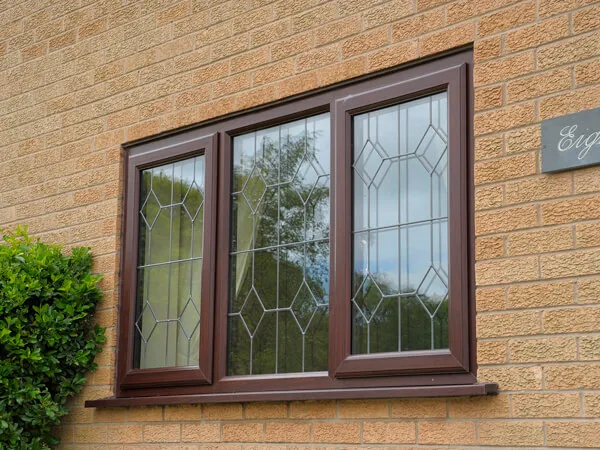
- Features
Casement windows are hinged at the side and open outward, making them perfect for drawing in fresh air and enjoying wide, open views. They’re tightly sealed when closed to lock in warmth and fitted with robust locking mechanisms for added peace of mind. - Best for
Equally at home in both period-style houses and contemporary builds, casement windows offer a timeless appeal that suits a wide range of UK property types. - Efficiency Rating
Thanks to their snug fit and compatibility with high-performance glazing, casement windows can achieve excellent energy ratings, especially when double or triple glazed with thermally efficient frame materials. - Design Options
Crafted in UPVC, aluminium or traditional timber, they can be styled to reflect anything from minimalist modern to authentic heritage looks. Choose from an extensive range of colours, including realistic timber finishes and contemporary tones. - *Average Cost
Prices are dependent on several factors such as window size, frame material, type of glazing, and any personalised features or finishes. ⭐ ⭐ ⭐
Sash Window
Sash windows became a staple of British architecture in the late 1600s, flourishing during the Georgian and Victorian periods.
Originally constructed with timber frames and smaller panes, these styles of windows have since been reimagined using modern materials like UPVC and aluminium, often incorporating larger expanses of glass for improved light and visibility.
Their signature sliding mechanism, whether vertical or horizontal, makes them instantly recognisable, while their refined styling continues to evoke a sense of heritage charm.
Centuries later, sash windows remain one of the most enduring and admired window styles found across homes in the UK.
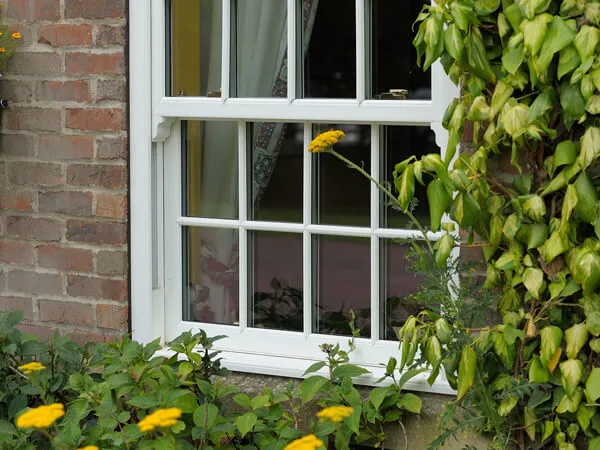
- Features
Sash windows function through a smooth gliding motion, with one or more sashes sliding either up, down, or sideways to adjust airflow and lighting. Their clever design also makes for effortless cleaning, particularly with inward-tilting models. - Best for
A seamless choice for period properties or newer homes aiming to channel classic elegance, sash windows suit a broad spectrum of architectural styles. - Efficiency Rating
When fitted with modern glazing and draught-proofing, sash windows can deliver commendable thermal performance, helping to reduce energy use and boost comfort. - Design Options
You can opt for UPVC, aluminium, or traditional timber frames, with a wide range of finishes from heritage hues to sleek contemporary tones. Styles include single-hung, double-hung, and horizontal sliders. - *Average Cost
Typically priced in the mid to upper bracket, the final cost will reflect your preferred materials, window size, glazing type, and any bespoke features. ⭐ ⭐ ⭐ ⭐
Tilt and Turn Window
Popular across European-style homes, tilt and turn windows are known for their clever design, combining security, thermal efficiency, and low upkeep.
They open in two ways: a gentle inward tilt for ventilation or a wide inward swing for full access, perfect for cleaning and enhanced control.
This smart dual action suits homeowners who value safety, airflow flexibility, and ease of use.
While they naturally complement modern properties, tilt and turn windows can also integrate well with more classic home styles.
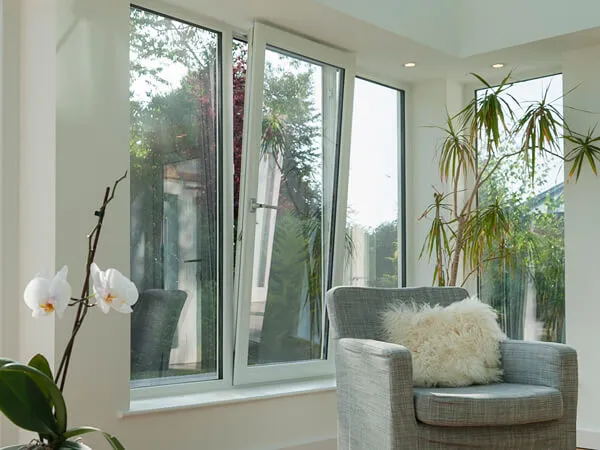
- Features
With an inward tilt for light ventilation and a full inward swing for full access, tilt and turn windows provide practical flexibility. Cleaning is refreshingly simple from inside, and they’re engineered to deliver excellent thermal insulation. - Best for
Commonly found in modern flats, contemporary homes and multi-storey properties, they’re especially suited to urban lifestyles and spaces that benefit from easy inward access. - Efficiency Rating
These windows typically meet or surpass energy efficiency benchmarks, especially when paired with double or triple glazing, secure locking, and airtight seals. - Design Options
Most often crafted in UPVC, but also available in aluminium, tilt and turn windows can be finished in a wide range of colours, including neutrals like white and greys. Choose from various layouts—single pane, multiple panes, or even floor-to-ceiling. - *Average Cost
Pricing depends on configuration, material and glazing, but while they can come at a premium, the extra functionality often justifies the cost. ⭐ ⭐ ⭐ ⭐
Sliding Window
Sliding windows function much like scaled-down patio doors, with sashes that glide horizontally along a track to open up space with ease.
Because they don’t swing inward or outward, they’re ideal in tighter areas where a protruding window wouldn’t work.
Their wide openings invite plenty of natural light and airflow, making rooms feel brighter and fresher.
Sleek, reliable, and low-maintenance, sliding windows deliver a smooth user experience and strong everyday performance across all home styles.

- Features
Sliding windows move horizontally along a track, offering fuss-free operation and saving space by not encroaching on the room when open. They’re great for boosting ventilation and keeping things simple and uncluttered. - Best for
Best suited to contemporary homes and mid-century designs that lean into clean lines and open views. - Efficiency Rating
Energy efficiency sits at a mid-range level by default but can be enhanced with double glazing and well-insulated frames. - Design Options
Available in UPVC or aluminium, with single or double sliders. Finish choices often include classics like white, black, and grey. - *Average Cost
Sliding windows tend to be a budget-friendly choice, but price points shift depending on the materials, features, and finish. ⭐ ⭐ ⭐
Bay Window
Bay windows are easy to spot thanks to their distinctive shape, jutting out from the main wall to form a stylish, light-filled nook.
They usually feature three glazed sections: a large central pane and two smaller angled windows on either side, which may be fixed or openable.
This projection not only boosts natural light but also adds a feeling of extra space, making rooms feel bigger and brighter.
Often found in living rooms, bay windows suit both traditional and modern homes, and it’s common to see a window seat or bench fitted into the recess to make the most of the inviting view.
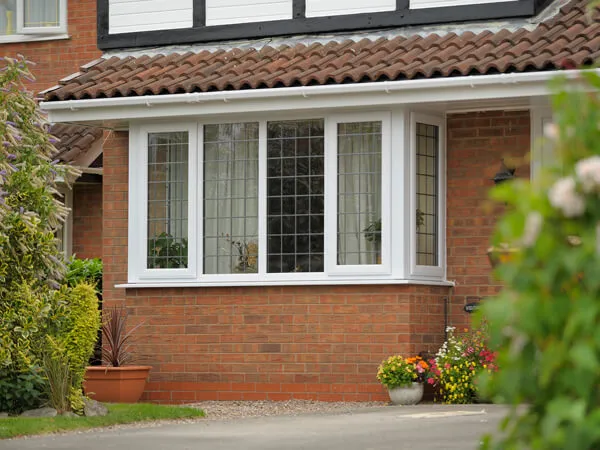
- Features
Bay windows extend outward to create extra interior space and wider outside views. Their striking shape adds kerb appeal and can positively influence property value. - Best for
A natural match for period and Victorian-style homes, bay windows accentuate charm and introduce extra depth and character. - Efficiency Rating
The larger glass area makes thermal efficiency key. Energy-efficient glazing helps minimise heat loss and keeps rooms comfortable throughout the seasons. - Design Options
Available in UPVC, aluminium, or timber, bay windows come in both traditional and modern styles, with finishes including white, cream, and authentic woodgrains. - *Average Cost
Costs vary based on section count (three to five), materials and glazing choices. The complexity of the design usually makes them pricier than standard windows. ⭐ ⭐ ⭐ ⭐
Bow Window
Bow windows, like bays, project outward, but with a softer, curved shape that forms a gentle arc.
Made up of four to six equal-sized panes, their subtle angles let in plenty of light and open up panoramic views.
Often featured in living rooms and bedrooms, bow windows add a graceful architectural touch and extend internal space.
These popular types of house windows are available in UPVC, aluminium, or timber, and suit both classic and contemporary homes looking for a standout feature.
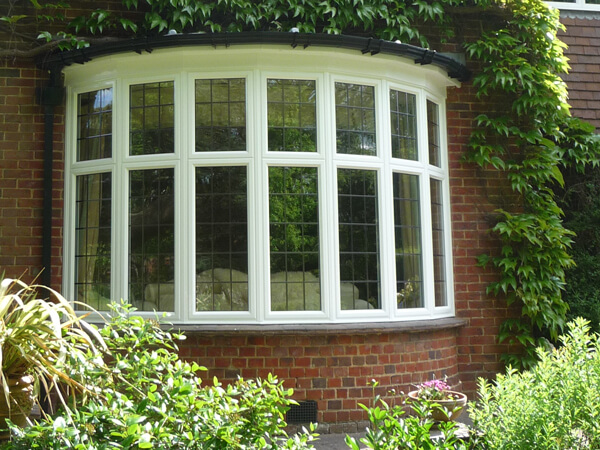
- Features
The multi-panelled bow window boasts a fixed or partially operable design with a gentle curve, brightening the home and offering a spacious atmosphere for its inhabitants. - Best for
Ideal for period properties, Victorian homes, and luxury modern residences, bow windows provide superb elegance and enhance the flow of natural light. - Efficiency Rating
Thanks to proper sealing, excellent insulation, and double or triple glazing, bow windows deliver moderate thermal efficiency, helping to keep your home comfortable year-round. - Design Options
Available in materials like timber, UPVC, and aluminium, bow windows are crafted in both classic and modern styles. Custom finishes are also offered for those seeking alternatives to the standard white, black, or wood finishes. - *Average Cost
The cost of bow windows can sometimes be higher than simpler designs, depending on factors like materials, glazing, and size. ⭐ ⭐ ⭐ ⭐
Rooflight/Skylight window
Rooflights or skylights, as they’re known by different names, are often integrated into the roofs or ceilings of lofts, extensions, and similar areas, where they help fill the space with much-needed daylight.
If equipped with an opening function, these windows can also act as a source of ventilation.
Made from toughened or laminated glass in a durable UPVC or aluminium frame, rooflights and skylights offer excellent thermal insulation and resistance to the elements.
Whether in new or traditional buildings, the additional light brought in by rooflights and skylights significantly reduces your need for artificial lighting.
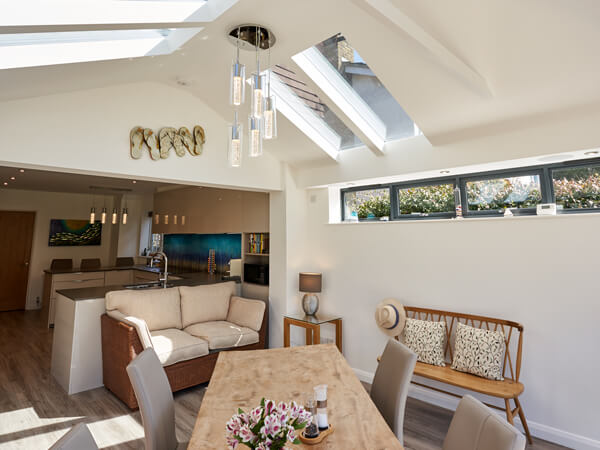
- Features
Installed in roofs, these fixed or vented windows channel natural light into living spaces, creating bright and airy environments that feel significantly larger. - Best for
Perfect for loft conversions, home extensions, and modern properties with minimal wall window options, rooflights and skylights can fill these areas with abundant daylight. - Efficiency Rating
Double or triple-glazed rooflights and skylights, when well-insulated, deliver impressive thermal performance, reducing heat loss and reliance on artificial lighting. - Design Options
Rooflight/skylight choices include fixed, manual, electric, flat roof, and pitched roof variants, with frames crafted from UPVC or aluminium in shades like white, grey, or black. - *Average Cost
Costs vary depending on the type and size of the rooflight/skylight; larger options will generally incur a higher price. ⭐ ⭐ ⭐ ⭐
Flush Window
Unlike the traditional windows that slightly project from the wall, flush windows capture attention with their perfectly aligned frames that sit level with the wall, creating a sleek and modern aesthetic.
Predominantly found in contemporary homes, today’s flush windows often feature energy-efficient glazing and a UPVC frame designed to resemble classic wooden frames, offering a nod to traditional flush window styles.
With their elegant design, flush windows increase natural light and prevent any risk of water ingress.
Thanks to their low maintenance needs, flush windows eliminate the ongoing upkeep required by traditional wooden frames.
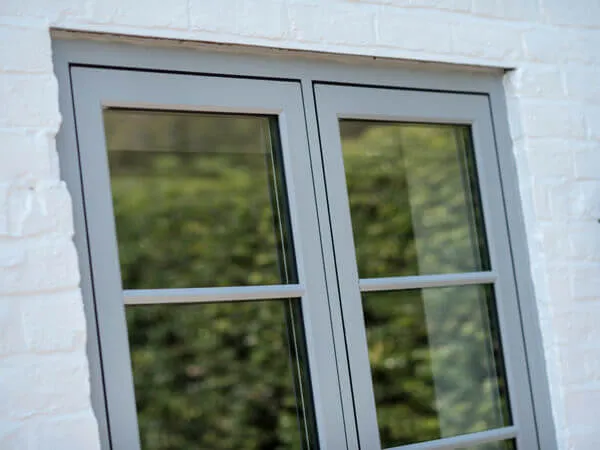
- Features
Flush windows blend effortlessly with the exterior walls, enhancing the clean and sharp lines of modern home designs. - Best for
Whether it’s a contemporary or period property, a flush window configuration adds an element of sleek elegance for those who appreciate modern simplicity. - Efficiency Rating
Even with their slender frames, flush windows can achieve impressive thermal efficiency when fitted with double or triple glazing and proper insulation. - Design Options
Once typically crafted from wood, modern flush windows are now commonly made from UPVC or aluminium, often finished in classic shades such as Light Oak, associated with the flush window style. - *Average Cost
The level of customisation will affect the price, with flush windows generally costing slightly more than standard casement windows.⭐ ⭐ ⭐ ⭐
Request Your Free Window Quote
Simply fill in your details for your free, no obligation quotation
Which Type of Window Would Work Best for My Home?
The ideal window style is the one that complements your property’s age and architecture, whether it’s newly built or rich in heritage.
Double-glazed windows are a smart choice for improving energy efficiency and keeping your space warm and draught-free.
Security matters too, so go for window types with strong built-in features like multipoint locking.
And don’t forget your own taste – these windows will be part of your everyday view, so choose a design you’ll love for years.
Above all, great replacement windows South Wales should combine style, performance, and practicality in equal measure.
Choosing the Right Window Frame: What Are the Options?
When fitted, window frames don’t just hold your glazing in place – they frame the style of your entire home, contribute to thermal performance, and influence how much upkeep your windows will need over time.
Most homeowners choose between four main types: UPVC, aluminium, composite and timber. Here’s what you need to know:
- UPVC
Standing for unplasticised polyvinyl chloride, UPVC window frames are a popular pick thanks to their thermal efficiency, low upkeep and long-lasting finish. Immune to rust, rot and discolouration, they’re widely available in different colours and profiles. - Aluminium
Don’t let the material fool you, aluminium frames are lightweight but incredibly strong. They’re resistant to rust and weather damage, with slender sightlines that lend themselves well to contemporary designs. - Composite
Crafted from a blend of timber, plastic and other materials, composite frames are built for performance. They deliver the aesthetic of timber without the hassle, resisting warping, swelling and heat loss with ease. - Timber
Natural timber brings character and warmth to a home, with unique grain detailing and timeless appeal. However, genuine wooden frames do call for regular maintenance, think staining or painting, to preserve their condition long-term.
What Is the Cheapest Style of Window?
As previously mentioned, the cheapest styles of windows will depend on a few key factors, namely, the material, glazing type, and overall design you go for.
UPVC casement windows are often the most cost-effective choice, largely due to the affordability of UPVC as a material. You’ll also usually pay less if you choose double glazing instead of triple glazing. Most types of double glazed windows will be more expensive than single glazed windows.
Another budgeting tip: the simpler the style, the lower the price. More intricate shapes and features will naturally bump up the cost.
What Are the Best Window Opening Styles?
When it comes to deciding which types of windows opening to go for, think about what will work best for your lifestyle, home layout, and personal style.
We’ve summarised the key options below to help you weigh up the pros and understand what each type brings to the table.
- Casement windows
These side-hinged windows open outwards, making them a practical pick for bringing in plenty of light and ventilation. - Sash windows
A timeless option that opens by sliding either vertically or horizontally. Great for saving space while still offering a steady flow of air. - Tilt and Turn windows
Versatile in design, they tilt open at the top or swing inwards, giving you better airflow and making it easier to clean from the inside. - Sliding windows
With horizontal panels that glide open, sliding windows are ideal for rooms where space is tight but ventilation is key. - Bay windows
Jutting out from the house in an angled design, bay windows brighten up rooms and add extra space indoors. - Bow windows
Similar to bays but with more glass panels, bow windows create a gentle curve that maximises natural light and enhances the feeling of space. - Rooflight/Skylight window
Perfect for lofts or rooms with limited wall space, rooflights let in overhead light and provide fresh air from above. - Flush windows
Fitted to sit level within the frame, flush windows are a sleek, stylish choice, often seen in modern or minimalist home designs.
A Quick Recap of What to Keep in Mind
There’s plenty to consider when it comes to choosing between the different types of windows for home improvement projects, so here’s a quick round-up of the essentials.
Take time to explore all the available styles, from casement to tilt and turn, and weigh up how each one performs in terms of usability, energy efficiency, benefits and cost. The easiest way to do this is by visiting a showroom.
It’s also worth looking into their compatibility with your property and weighing up the best frame materials and glazing options.
*Price rated from 1-5 stars (1= very low cost, 5= expensive)
Looking for new replacement windows?
Old favourites such as the Sash Window and Casement Window, sit alongside contemporary innovations including our latest flush range available in double glazing or triple glazing options.
Request your Free Quote
Simply fill in your details for your free, no obligation quotation, and click "Get Quote"